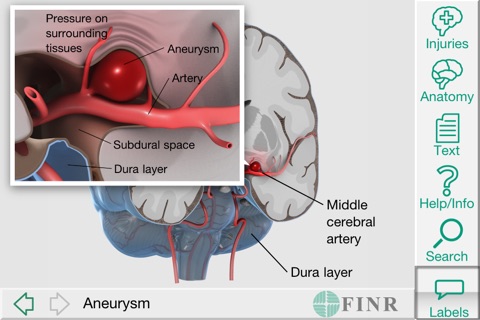
FINR Brain Atlas app for iPhone and iPad
Developer: Florida Institute for Neurologic Rehabilitation, Inc.
First release : 17 Mar 2011
App size: 557.89 Mb
Explore the anatomy of the brain and common brain injuries in a 3-dimensional model. Detailed descriptions include the function of normal structures, related structures, common injuries to those areas, and resulting deficits due to damage.
Injury illustrations include:
• aneurysm,
• anoxic/hypoxic encephalopathy,
• cerebral contusion,
• cerebral infarction/stroke,
• diffuse axonal injury,
• intraventricular hemorrhage,
• penetrating head wound,
• subarachnoid hemorrhage, and
• subdural hematoma.
Manipulating the brain model
•Swipe your finger on the brain to rotate it horizontally or vertically.
•To zoom in or out, pinch the brain with two fingers.
•To pan, swipe the brain with two fingers.
Pop-up labels
•Tap a colored region on the brain to reveal a pop-up label. Labels that appear green, with an underline are hyperlinked to corresponding structures. Simply tap on a link to load its structure.
Controls
•Tap Injuries and select one of the 9 injuries listed.
•Tap Anatomy and select one of the 29 anatomical regions or structures from the list.
•Enter one or more search words. The app returns matches within the descriptive text for all injuries and anatomy. Tap the match you wish to view.
•Tap the arrows to go to previously viewed injuries and anatomy.
•Toggle automatic rotation on and off.
•Turn labels on and off for relevant structures. Each injury starts with the labels on, by default.
•Toggle the labels OFF or simply swipe your finger on the brain to make them disappear.
•Toggling labels ON resets the brain to its default size and position on the screen.
The text box displays descriptions of normal function and the consequences of damage/injury. To scroll through the text, swipe the screen with your finger. Underlined words are hyperlinked to other structures and injuries within the Atlas. Tap on a hyperlink to load the corresponding structure.
Latest reviews of FINR Brain Atlas app for iPhone and iPad
The labels feature has stopped working for iPad. Fixing this glitch will get this app back up to 5 stars for me. I love using it for study and tutoring sessions, but non working labels defeats the purpose.
GREAT Program. Clear images, descriptive, interactive. Highly recommended. A++++. Great for everyone of all levels!!!
I bought this program before it had any ratings and wow, Im impressed by the level of detail, interaction, and ease of use. Great app for learning about the brain if youre a student. I would like to see the publisher add more brain disorders in the future
Great !!!!!!!!!!!!!!!!!!!!!!!!!!!!
A nice app. Very similar to the free app 3D brain. If this one receives an update with many more disorders and more identified structures it will be far superior. Also needs to be updated to allow viewing of only the brain if selected rather than always the text too.



